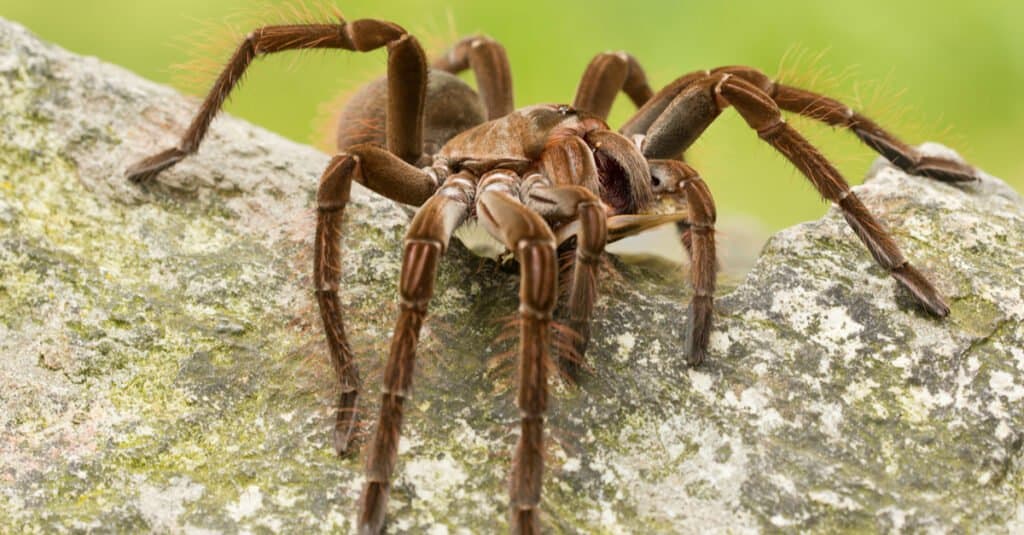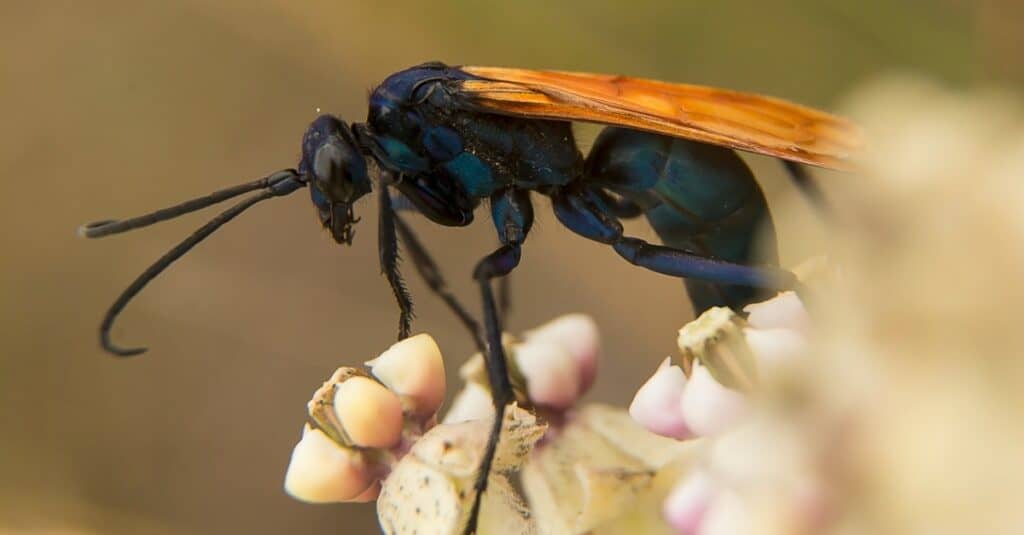The world of insects is filled with interesting creatures and deadly battles waiting to happen. One of the most feared arthropods is the tarantula, a large spider with long fangs and a potentially deadly bite it can inflict upon other insects. As powerful as this creature may be, it’s not the toughest or deadliest insect out there. For example, the tarantula hawk is a large wasp that uses venom to paralyze its foes and prepare them for a horrible end. So, which insect wins the tarantula hawk vs tarantula battle?
We’re going to break down this fight from multiple dimensions to show you which animal walks away alive and how a battle would go!
Comparing a Tarantula Hawk and a Tarantula

| Tarantula Hawk | Tarantula | |
|---|---|---|
| Size | Weight: 0.35 to 0.67 ounces Length: about 2 inches | Weight: 0.5 oz-3 oz Length 2 in to 4.5 in |
| Movement Type | – Capable of flying – Often flies low to the ground and slow – Effective at moving on the ground | – Scurries on the ground – Moves faster when it’s warm out |
| Defenses | – Strong integumentary exoskeleton – Bright colors scare off predators as a form of aposematism | – Medium-length hairs that can act as barbs and auxiliary senses – Speed – Ability to hide in burrows – Primarily acts at night |
| Offensive Capabilities | – Massive stinger measuring up to ¼ inch in length – Hooked claws on the legs to help them stay latched to prey – Venom is powerful against invertebrates – An immensely painful sting that can paralyze insects, especially tarantulas – Stings tarantulas at a weak spot between their legs, paralyzing them in seconds | – Venomous bite that can kill insects or cause discomfort in humans – Powerful mouthparts that bite downward, pushing their massive fangs toward a row of sharp teeth to crush the prey |
| Predatory Behavior | – Opportunistic predator that finds tarantulas by smell – Takes the tarantula back to their burrow and deposits an egg in the victim’s stomach – The egg hatches and consumes the prey | – Ambush predator – Hides in the brush near their burrows and kill attacks their prey |
What Are Key Differences Between a Tarantula Hawk and a Tarantula?

This
scary animal
injects its prey with a juice that liquefies all but the skin and bones.
©iStock.com/Dan Olsen
The greatest differences between a tarantula hawk and a tarantula include size, locomotion, and offensive capabilities. For example, the tarantula hawk is about 2 inches long and 0.67 ounces in weight, flies as its form of locomotion, and has a powerful, venomous sting that paralyzes and kills its foes, but the tarantula is a terrestrial creature that scurries on the ground, uses bites and barbs to find and kill prey, and measures up to 4.5 inches long and 3 ounces in weight.
These differences are important to explore because they allow us to see what elements of these insects serve as advantages and drawbacks in a fight. Let’s take a closer look at these key factors.
What Are the Key Factors in a Fight Between a Tarantula Hawk and a Tarantula?

Tarantulas have the size advantage, but that’s about all
©Milan Zygmunt/Shutterstock.com
Every fight in the animal kingdom boils down to a handful of factors. When trying to determine the winner of a bout, we must look at five general topics. Size and speed are important, but we must also look at defensive and offensive powers along with how these animals hunt others.
By closely comparing each creature, we can see which one has the advantage in each of these valuable traits.
Tarantula Hawk vs Tarantula: Size
A tarantula is larger than a tarantula hawk. The average tarantula weighs between 0.5 and 3 ounces, and they measure about 2 to 4.5 inches in length. The tarantula hawk is smaller, weighing about 0.67 ounces and measuring only about 2 inches long.
Tarantulas have the size advantage against the tarantula hawk.
Tarantula Hawk vs Tarantula: Movement
The tarantula hawk is a flying wasp. This creature flies but it also tends to stay low to the ground so that it can find prey, namely tarantulas. When it finds prey that it wants, it will crawl on the ground to land a sting using some rather agile maneuvers.
However, the tarantula scurries along the ground and moves somewhat swiftly. However, it is still slow enough that it can be caught by predators.
The tarantula hawk has the movement advantage.
Tarantula Hawk vs Tarantula: Defenses
The Tarantula hawk has a form of aposematism with its rust-colored wings and blue highlights throughout its body. These colors are a warning that they are venomous and not easy prey. Moreover, they have a tough exoskeleton that can take some punishment before any serious harm befalls the critter. Of course, they also can fly away from trouble.
Tarantulas are stealthy creatures that mostly hunt at night to avoid predators. Moreover, they have medium-length hairs across their bodies that act as barbs and auxiliary senses in a nice two-for-one combo. These spiders also enjoy hiding in burrows, allowing them to stay safe when they’re not hunting.
The tarantula has better defenses than the tarantula hawk.
Tarantula Hawk vs Tarantula: Offensive Capabilities
The tarantula hawk is built to kill tarantulas. They have a stinger that measures almost a quarter inch in length. That stinger delivers a powerful venom to the tarantula hawk’s victims, especially spiders and other arthropods. The venom is very strong against invertebrates, and it can paralyze or kill foes.
That’s not all they have, though. The tarantula hawk also has a pair of powerful hooked claws that help it keep a hold on prey while it delivers its stings.
The tarantula spider has a venomous bite that can kill insects and cause pain in people. They use their strong mouthparts to grasp prey and then bite downward with their large fangs, driving the prey back into a row of sharp teeth that help it kill prey with ease.
All told, the tarantula hawk has the offensive advantage of its brilliant combination attack.
Tarantula Hawk vs Tarantula: Predatory Behavior
For the most part, tarantula hawks are opportunistic predators. They seek out their favorite meal, tarantulas, by scent. Once they find them, they land near them, dive onto their backs, and sting the spider between its legs. The venom incapacitates the prey in seconds.
From there, the tarantula hawk will drag the spider back to its burrow, deposit an egg in its stomach, allow it to hatch, and then the offspring eats the prey while it is still alive. It’s every bit as horrible as it sounds.
The tarantula is much more straightforward. They are ambush predators that hide in brush and undergrowth near their burrows, lunge at prey, and kill it with their large fangs and venom.
The tarantula hawk has better predatory behaviors and an advantage.
Who Would Win in a Fight Between a Tarantula Hawk and a Tarantula?

A tarantula hawk can easily overpower a tarantula
©iStock.com/Thom_Morris
A tarantula hawk would win a fight against a tarantula in the vast majority of cases. Basically, this is the tarantula hawk’s battle to lose. They have the means to stop the spider in its tracks within seconds and have a strong exoskeleton to keep them safe during combat.
This flying wasp is an expert at killing tarantulas, so there are few ways that the spider can walk away from this alive. The tarantula hawk will perform a diving sting that ends the fight in seconds. Even if the tarantula managed to grab this wasp in its mouthparts, it may slip out because its carapace is hard and smooth. Moreover, the tarantula would have a hard time breaking or piercing this outer shell without getting stung.
Unless the tarantula makes a mad dash away from the tarantula hawk, it’s going to be a victim of the powerful, scary venom.
Who Could Ultimately Beat a Tarantula Hawk in Battle?
Many animals are capable of fighting a Tarantula Hawk and winning, depending on the size and strength of the animal. For example, larger animals like bears or wolves, who have strong claws and teeth to defend themselves with, could potentially overpower a Tarantula Hawk in a fight. Even smaller predators, such as foxes or coyotes, may be able to win if they manage to surprise the Tarantula Hawk by attacking from behind or at an angle it can’t see.
Other animals that could potentially come out victorious include snakes, which can use their long bodies to wrap around and constrict their prey. Birds of prey would also be victorious, such as hawks and eagles, and can attack the Tarantula Hawk from above. Lizards have powerful jaws for gripping and may be able to catch the Tarantula Hawk unawares. Even frogs, which have sticky tongues they can use to snatch up their prey, may win this battle.
The photo featured at the top of this post is © iStock.com/Rainbohm
Thank you for reading! Have some feedback for us? Contact the AZ Animals editorial team.






